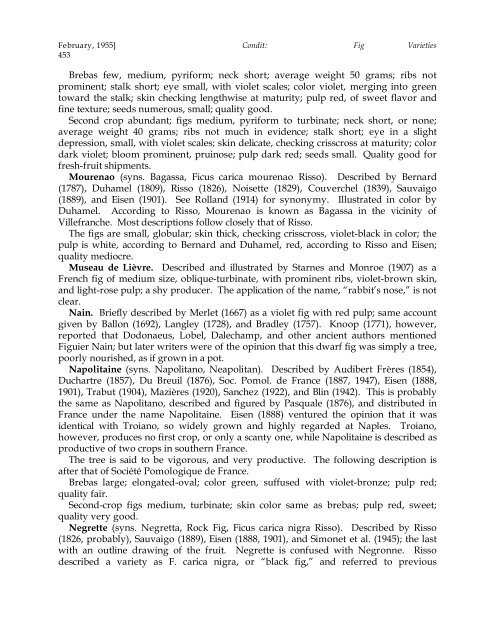Fig Varieties: A Monograph - uri=ucce.ucdavis
Fig Varieties: A Monograph - uri=ucce.ucdavis
Fig Varieties: A Monograph - uri=ucce.ucdavis
Create successful ePaper yourself
Turn your PDF publications into a flip-book with our unique Google optimized e-Paper software.
February, 1955] Condit: <strong>Fig</strong> <strong>Varieties</strong><br />
453<br />
Brebas few, medium, pyriform; neck short; average weight 50 grams; ribs not<br />
prominent; stalk short; eye small, with violet scales; color violet, merging into green<br />
toward the stalk; skin checking lengthwise at maturity; pulp red, of sweet flavor and<br />
fine texture; seeds numerous, small; quality good.<br />
Second crop abundant; figs medium, pyriform to turbinate; neck short, or none;<br />
average weight 40 grams; ribs not much in evidence; stalk short; eye in a slight<br />
depression, small, with violet scales; skin delicate, checking crisscross at maturity; color<br />
dark violet; bloom prominent, pruinose; pulp dark red; seeds small. Quality good for<br />
fresh-fruit shipments.<br />
Mourenao (syns. Bagassa, Ficus carica mourenao Risso). Described by Bernard<br />
(1787), Duhamel (1809), Risso (1826), Noisette (1829), Couverchel (1839), Sauvaigo<br />
(1889), and Eisen (1901). See Rolland (1914) for synonymy. Illustrated in color by<br />
Duhamel. According to Risso, Mourenao is known as Bagassa in the vicinity of<br />
Villefranche. Most descriptions follow closely that of Risso.<br />
The figs are small, globular; skin thick, checking crisscross, violet-black in color; the<br />
pulp is white, according to Bernard and Duhamel, red, according to Risso and Eisen;<br />
quality mediocre.<br />
Museau de Lièvre. Described and illustrated by Starnes and Monroe (1907) as a<br />
French fig of medium size, oblique-turbinate, with prominent ribs, violet-brown skin,<br />
and light-rose pulp; a shy producer. The application of the name, “rabbit’s nose,” is not<br />
clear.<br />
Nain. Briefly described by Merlet (1667) as a violet fig with red pulp; same account<br />
given by Ballon (1692), Langley (1728), and Bradley (1757). Knoop (1771), however,<br />
reported that Dodonaeus, Lobel, Dalechamp, and other ancient authors mentioned<br />
<strong>Fig</strong>uier Nain; but later writers were of the opinion that this dwarf fig was simply a tree,<br />
poorly nourished, as if grown in a pot.<br />
Napolitaine (syns. Napolitano, Neapolitan). Described by Audibert Frères (1854),<br />
Duchartre (1857), Du Breuil (1876), Soc. Pomol. de France (1887, 1947), Eisen (1888,<br />
1901), Trabut (1904), Mazières (1920), Sanchez (1922), and Blin (1942). This is probably<br />
the same as Napolitano, described and figured by Pasquale (1876), and distributed in<br />
France under the name Napolitaine. Eisen (1888) ventured the opinion that it was<br />
identical with Troiano, so widely grown and highly regarded at Naples. Troiano,<br />
however, produces no first crop, or only a scanty one, while Napolitaine is described as<br />
productive of two crops in southern France.<br />
The tree is said to be vigorous, and very productive. The following description is<br />
after that of Société Pomologique de France.<br />
Brebas large; elongated-oval; color green, suffused with violet-bronze; pulp red;<br />
quality fair.<br />
Second-crop figs medium, turbinate; skin color same as brebas; pulp red, sweet;<br />
quality very good.<br />
Negrette (syns. Negretta, Rock <strong>Fig</strong>, Ficus carica nigra Risso). Described by Risso<br />
(1826, probably), Sauvaigo (1889), Eisen (1888, 1901), and Simonet et al. (1945); the last<br />
with an outline drawing of the fruit. Negrette is confused with Negronne. Risso<br />
described a variety as F. carica nigra, or “black fig,” and referred to previous
















![Fig Trees in North Carolina [Archive] - IDigMyGarden ... - Figs 4 Fun](https://img.yumpu.com/26905320/1/190x245/fig-trees-in-north-carolina-archive-idigmygarden-figs-4-fun.jpg?quality=85)